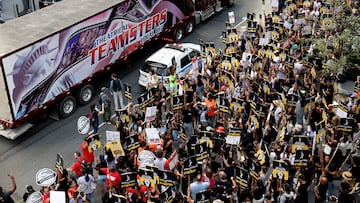Why isn’t Labor Day held in May in the United States?
The United States is one of just a handful of countries that celebrates Labor Day but not on 1 May as the vast majority do. Find out why that i

International Workers’ Day originated from events that took place in the US. Despite this, Labor Day is celebrated in September, and the global holiday is often overlooked. With the resurgence of the labor movement and an increase in workplace organization, many cities in the US are now hosting parades to recognize the invaluable contributions of workers on May Day.
In the US, Labor Day has been held on the first Monday in September since the 1880s. There have been efforts to switch it to May to align it with International Workers’ Day, but remnants of Cold War tensions have soured this endeavor.
A brief history of International Workers’ Day
While the US does not celebrate International Workers’ Day, the Haymarket Massacre in Chicago inspired the Marxist International Socialist Congress to choose 1 May as their day of action in Paris in 1890.
On 1 May 1886, the Federation of Organized Trades and Labor Unions, which later changed its name to the American Federation of Labor, called on its members to strike for an eight-hour workday. In Chicago, workers at the McCormick Harvesting Machine Company participated in a strike to demand that their leadership implement the change. More than 400 police officers guarded the factory to prevent the entrance of the workers on strike. On the third day of the strike, a few protestors tried to break through the police line to confront the strikebreakers, and they were shot. Local anarchist groups quickly released a pamphlet detailing the event and encouraged workers to join a rally at Haymarket Square the following day.
Details on the number of workers who participated in the rally are unclear and range from 600 to 3,000. Those in attendance chanted, marched, and listened to speeches. Towards the end of the day, police moved into the area to disperse the protestors, and before they reached the crowd, a bomb was thrown in the direction of the police. The officers quickly began shooting, creating a stampede and chaos that left six police dead and 60 wounded. As for the workers, two deaths were confirmed, but the total death and injury count was never released.
Repression of the labor movement swiftly followed, but the event would later be recognized as a critical moment in the US labor movement’s struggle for an eight-hour workday.
Attack on organized labor in the 20th century
The Marxist and socialist ties to International Workers Day made it popular among organized labor in the US in the early part of the 20th century. However, in the decades that followed, as the Cold War progressed and the Red Scare motivated the ever-increasing attacks on organized labor, the idea of moving the US Labor Day to May became politically toxic.
Unionization in the US reached its peak in 1950. That year more than a third of all workers in the country were card-carrying union members. Union membership was popular since it was organized labor that won major victories for workers. Additionally, muckrakers, activists, and unions improved the safety conditions of workers and encouraged that laws be passed to protect children from exploitive labor practices.
After World War II, Cold War politics motivated the US government to restrict the power of organized labor, and laws like the Taft-Hartley Act made it illegal for unions to contribute to political campaigns. Today, this idea seems ludicrous to many as the Citizens United Supreme Court decision allows corporations to donate to campaigns.
Additionally, the law severely limited the ability of unions to encourage striking, saying that the practice formed a threat to national security. The bill was also influenced by McCarthyism and required that union leaders state publically that they had no ties to the Communist Party and that they had no intention of overthrowing the government. This provision of the bill was deemed unconstitutional in 1965, but by then, many leaders had been accused of communist loyalties and removed from their posts.
Today, the impacts of the Taft-Hartley and other anti-union bills are clear, as union membership in the US hit a historic low of 10.1% before recovering to 11.3% in 2022.






